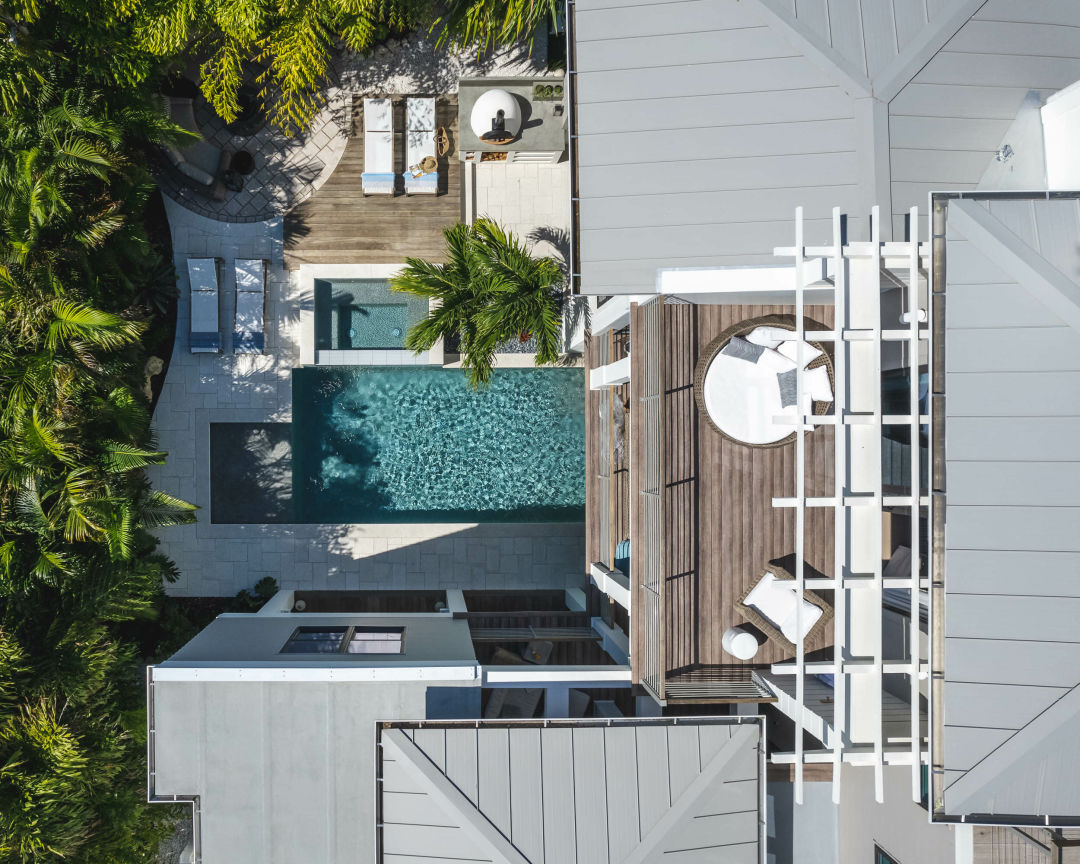This Anna Maria House Is Packed With Sustainable Style

210 Fir Ave. on Anna Maria Island, Manatee County.
Image: David Cannon
Near Anna Maria Island’s northernmost tip, a previously vacant lot is now home to a new build that’s dotted with cozy nooks on the inside and spaces that showcase an obsession for being outside.

An aerial picture of the home.
Image: David Cannon Photography
The lot on Fir Avenue that Laura Freeman and her husband bought back in 2019 was, at the time, a tangled jungle Freeman refused to set foot on. But a drone image of the nearby Gulf view cemented her vision for what could go there—and it wasn’t the ubiquitous coastal cottage.
Instead, she says, she wanted a “California modern meets British West Indies,” kind of home.
Now, after three years of building, working closely with Dan Gagne of Gagne Construction and architect David Wash, the two-level, four-bedroom, four-and-a-half-bathroom is exactly what she dreamed it could be.

The kitchen, with Freeman's dog Zoey lounging in the background.
Image: David Cannon Photography
Freeman, 56, who splits her time between Atlanta and Anna Maria Island, has a master's degree in interior architecture and design and once worked for Disney, designing the vice president’s office and global resorts studio. She broke away to pursue a passion for sustainable design and started her own firm, Merits Design Group, where her LEED and Well AP credentials inform her approach.

Sustainable rattan and bamboo high chairs.
Image: David Cannon Photography
Freeman also points to biophilic design, which embraces humans’ natural love of connecting to nature. “This house is about that,” she says.
“Whether you're looking at natural wood, or outside, or seeing the sunlight pour in, there’s a connection,” she adds. “Good things happen to us when we indulge in that [connection to nature]. It’s what feels calming and comfy.”

Two hanging nest chairs by the pool.
Image: David Cannon Photography

Dining nook
Image: David Cannon Photography
With her clients, Freeman often starts with the question, “What are the things in nature that you marvel at?” It's the same one that inspired some of the tiles she used in the home, which mimic the water ripples on the sand at the beach.

Bringing the outdoors in with lots of windows that open onto balconies and outdoor spaces.
Image: David Cannon Photography
She designed the shutters, which cast graphic, sharp-hewn sunrays and shadows and recall her past career as a graphic designer. Repurposed French flour sifters serve as living room side table tops. A vintage Belgian chocolate mold serves as the base for another side table. The light fixtures throughout are from Graypants, a company that makes them entirely out of recycled cardboard.

The side tables are repurposed vintage flour sifters.
Image: David Cannon Photography

Another nook that connects to the outdoors.
Image: David Cannon Photography
Sustainable and recycled are part of her ethos. The floor is hickory and the ceilings are reclaimed pine. In fact, the ceiling planks came from a salvaged estate in New Jersey and the shelves and desktop in the office from a home in northern Georgia. As luck would have it, “because we built during Covid, the recycled material was cheaper than traditional lumber,” Freeman recalls. Lumber costs had soared at the time.

One of four bedrooms.
Image: David Cannon Photography

Custom built-ins make the space more efficient.
Image: David Cannon Photography
The layout eschews the ubiquitous open floor plan that’s mashed together every kitchen, dining and living room for years now. Instead, Freeman opted for intimate spaces and a “modular approach,” she says. “There’s little nooks where someone can read or scroll on their cell phone or pair up and play cards. If we have 12 people over, we can go off and come back together for sunset on the roof deck.”

Rooftop deck
Image: David Cannon Photography
That deck is one of the home's many outdoor spaces. There’s a covered area with a pool, spa and outdoor shower, along with balconies off the second floor. There’s an outdoor kitchen and dining area, along with a fire pit circled by a couch. A custom brick pizza oven is a communal focal point, where Chicago deep-dish pizzas are on the menu. (Freeman's favorite is tomato sauce with mozzarella and anchovies.) A ping pong table and cornhole invite play.

The outdoor pizza oven.
Image: David Cannon Photography
Laura Freeman's Sustainable Design Takeaways
How to bring the outside in.
Start with nature and your happy place
“One client loved Hawaii, so we created a palette that included the black of the lava rock and vibrant greens from the tropical plants," Freeman says. "Another client wanted a lake house vibe, so we pulled in blues for water, woody browns and tree leaf colors." For this house, it was whites, blues and neutrals pulled from walks on the beach, just down the street.

Outdoor kitchen and dining area.
Image: David Cannon Photography
Origins count
“If I'm buying new, I look for sustainable, recycled, fair trade or made-in-the-USA pieces for a smaller carbon footprint to limit transportation," Freeman says. "Rattan and bamboo are fabulous sustainable materials, for instance.”

One of four-and-a-half-bathrooms
Image: David Cannon Photography
Repurpose
“When possible, I repurpose furniture the client already has," Freeman says. "One client had huge sofas that were too big for the new space they were in but they were in good shape. I added new covers, separated them and placed them in different rooms. Choose the pieces you already have and love, and be willing to use them in a different way or a different room.”

Outdoor shower
Image: David Cannon Photography
Love the backstory
“Being a designer doesn't mean you say, 'Everything must go!'' Freeman explains. "Some pieces tell a story about a family member; I want to honor that. Other times it's appropriate to put new hardware to dress up an older piece of furniture and update it.”

Original Nigerian shields hang on the all.
Image: David Cannon Photography
Incorporate vintage finds
“Incorporating vintage can add a personal warmth. Go to antique markets and find a chair that needs a fresh coat of paint and a cushion," Freeman advises. "It’s so satisfying to give new life to older pieces with your own take.”
Prioritize functionality
“Many clients assume ‘this goes there’ without asking, ‘How do I use the space?’" Freeman says. "Don't copy the picture you've seen in a magazine. Cater to your everyday needs instead.”

A wet bar and coffee station.
Image: David Cannon Photography
Use high-performance and organic textiles
“Go for washable [textiles] or ensure nothing is too precious so that no one can use it," Freeman says. "Consider reclaimed materials and Crytpon fabrics for durability. Bamboo linens, cotton and organic materials are my go-to, and my rugs are made from recycled plastics. Remember, sandy feet are welcome inside!”

A covered outdoor area on the second level.
Image: David Cannon Photography
Let light play
“Shadows are one of the 14 points of biophilic design. There is a mystery in dappled sunlight and slats creating shadows. If you’re not getting dressed in front of a window, consider leaving it bare of window treatments," Freeman suggests.

Slats and gables create light and shadow play.
Image: David Cannon Photography
Forego faux plants
“There are some top-grade products but most are made from petroleum-based plastics," Freeman says. "I would say opt for real, low-maintenance plants. The faux ones collect dust and allergens.”

Low maintenance plants
Image: David Cannon Photography
Less is more
“If you think you’re picking out the right amount of furniture for a room, get two fewer pieces," Freeman says. "Just because a space is empty doesn't mean it has to be filled. There is beauty in negative space, too.”



